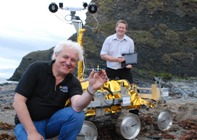Medieval stained glass inspires

Professor Dave Barnes (left) and Dr Stephen Pugh during recent field trials on Clarach beach.
29 September 2010
The magnificent stained glass windows that adorn medieval cathedrals have provided the inspiration for a team of space scientists looking to capture the true colours of Mars.
The space robotics team at the Department of Computer Science is leading the development of the camera calibration target for the 2018 ESA ExoMars mission.
Integral to the camera’s calibration target are small stained-glass coloured chips manufactured using a process very similar to that used in medieval times.
“Mars has little to no ozone in the atmosphere and this means that the high UV radiation can cause colours to fade when exposed to sunlight”, explains Professor Dave Barnes, who is leading the ExoMars Rover work at Aberystwyth.
“The stained-glass idea comes from observing the many brightly coloured windows in churches. These have been exposed to sunlight for centuries and show little to no colour degradation,” he said.
Images of the Martian surface will be captured by the ExoMars rover’s Panoramic Camera (PanCam) instrument.
The Aberystwyth team will be responsible for processing these returned images using a variety of computer vision techniques and algorithms developed at the University.
One problem is that the Martian environment casts an unwanted hue over all captured images due to the fine dust particles in the atmosphere.
Scientists want the returned images to be colour corrected (as if they were being viewed by a human) to help them in identifying potential science targets for further investigation.
To do this a PanCam Calibration Target (PCT) must be mounted on to the ExoMars rover and every time a sequence of images is captured, images of the PCT are also taken.
The PanCam is a monochrome multi-spectral instrument. Using the images taken with the available filters, in combination with the data obtained from the images of the PCT, it is possible to generate true colour images of the Martian terrain.
The space robotics team is working with colleagues from the Institute of Mathematics & Physics who have the necessary glass expertise.
Measuring just 50 mm × 50 mm, 18 mm high and weighing just 20 grams, the PanCam Calibration Target is tiny, yet its contribution to the quest for life on Mars may yet be enormous.
The PanCam and PCT work is funded by the UK Space Agency.
AU9910



